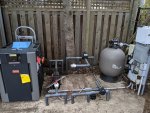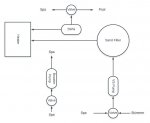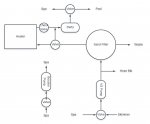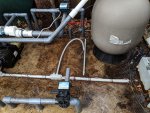My builder plumbed my pool with 1.5" pipe throughout. I'm in the midst of replacing heater, pump and SWG and wondering if this a good opportunity to re-plumb the pad in 2". I figure it will cost me an extra $800 to do it since I would have to replace the valves (Jandy NeverLube) and perhaps the sand filter. The filter looks like it has 1.5" ports.
The new heater and SWG come with 2" fittings. The Pentair Superflow VS pump I bought has 1.5" fittings but I think I could probably exchange it for a 2" model.
My question is, am I going to see a lot of benefit from going to 2" considering the piping to the pool is 1.5"?
Photo of pad attached. I've removed pump, SWG and old heater. The new heater is not yet connected.

The new heater and SWG come with 2" fittings. The Pentair Superflow VS pump I bought has 1.5" fittings but I think I could probably exchange it for a 2" model.
My question is, am I going to see a lot of benefit from going to 2" considering the piping to the pool is 1.5"?
Photo of pad attached. I've removed pump, SWG and old heater. The new heater is not yet connected.






